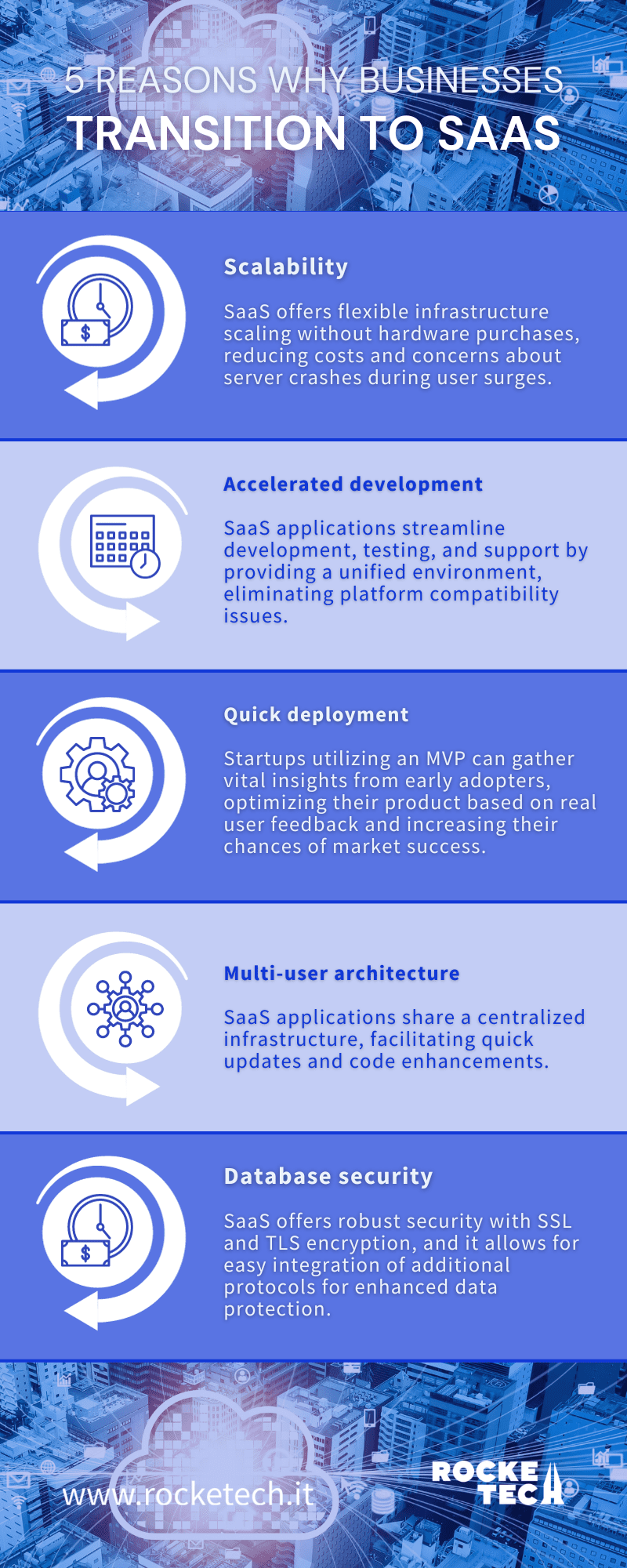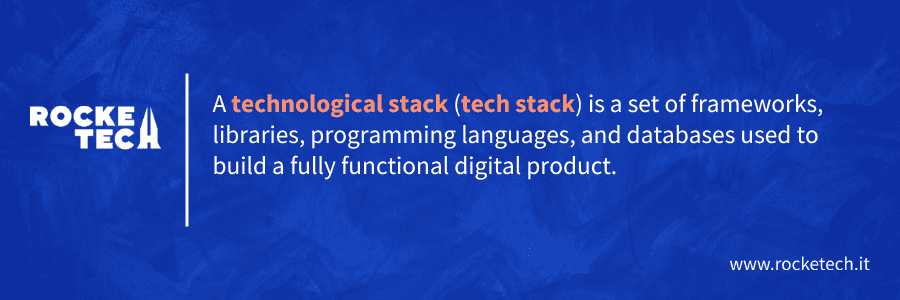Until very recently, the Software-as-a-Service model was something large corporations offered their clients. It meant years of development, thousands of people writing the code 24/7, and fabulous amounts of money. Well, things have dramatically changed.
Today, even small startups can deliver their product ideas to their customers through SaaS solutions and build the latter even with limited budgets. You just need to figure out how to outsource SaaS product development and what to consider when looking for a tech vendor. Here’s what you need to know.

A Few More Words on the Concept of Software as a Service
Software as a Service (SaaS) is a web application delivered to end users over the Internet. Rather than installing and managing software on their own devices, SaaS provides a subscription-based model that helps users conveniently access the complete application, along with its IT infrastructure.
Why Do Businesses Transition to SaaS?
There’s a multitude of reasons behind many SaaS development outsourcing options. The key drivers behind this strategic transition range from scalability and accelerated development to quick deployment and enhanced security.

Scalability
There’s no need to worry about servers crashing if the number of users suddenly increases. Transitioning to the SaaS model implies that companies can expand their infrastructure capabilities as needed without purchasing new hardware and other necessary components. Costs in such an approach will be much lower than upgrading one’s own equipment.
Accelerated Development
Local applications need to be developed and tested for various platform combinations like device hardware, operating systems, security settings, etc. In contrast, SaaS applications are created in a unified controlled environment. It significantly simplifies and speeds up development, debugging, and support.
Quick Deployment
Deploying local applications within a company can take months. With SaaS, it’s enough to set up the application once to meet the company’s requirements and then distribute logins and passwords to its employees. This leads to another advantage — a short sales cycle. With SaaS, there’s no need to spend weeks or months building customer relationships and planning deployment. The time saved can be used to improve the product and enhance customer service.
Multi-User Architecture
All application’s users share a centralized infrastructure and code. It allows for a quick update release and saves time on code enhancements.
Database Security
Standard security protocols provided by SaaS database providers include SSL and TLS encryption. They secure user messages and data. On top of that, the SaaS model allows for easy and fast integration of additional protocols to enhance security.
SaaS Development: What You Need to Know Before Hiring a Tech Vendor
The point of delegating a complex tech project to a third party is to find a professional team that would bring the necessary expertise to the table. While you don’t have to be really dev-savvy to outsource SaaS development, you’ll have better chances to choose the right vendor if you at least understand the development process basics. Here are the most essential aspects of a SaaS development project.
SaaS Architecture
SaaS applications’ architecture is designed to meet business needs like requirements for reliability, fault tolerance, and financial capabilities.
Today, multi-tenancy architecture serves as the foundation for nearly every SaaS product operating in the cloud. It helps reduce costs, improve the efficiency of resource utilization, ensure scalability, and enable rapid deployment of updates.
In cloud computing, there is a concept called “multi-tenancy,” where multiple customers (tenants) of a cloud service provider use the same computing resources and operate within a shared environment. Even though tenants share the infrastructure and resources, they are isolated from each other.
In other words, each company is physically integrated but logically separated. You can think of it like real estate.
Imagine the cloud as a building. Living in a private house far from neighbors isn’t land efficient and requires property maintenance.
Multi-tenancy is like living in an apartment building. Everyone has the same security system, but each tenant has their own key to their apartment, ensuring their privacy. Tenants can make modifications or furnish their apartments according to their requirements and preferences, just as a company configures its portion of the cloud infrastructure.
Launch with Rocketech.
Key Components
An application’s main features set one app type apart from another. However, there are key components every SaaS solution must have.
- Customizable Infrastructure
One of the advantages of using SaaS architecture is the customizable infrastructure that can be expanded or scaled down based on business requirements. For example, customers can decide which components benefit their business and pay only when necessary. At the end of a paid period, customers can return to their previous infrastructure model.
SaaS users purchase their software in a billing system on a monthly or yearly basis. Their requirements may increase or decrease depending on their business needs and consumer demand, so having a customizable infrastructure is essential.
- Subscription-Based Pricing Model
The SaaS application’s essence lies in its high availability. This service is extended through a flexible billing cycle that allows customers and business users to use what they want, as much as they want.
- CRM System
A Customer Relationship Management (CRM) system is what sets a SaaS application apart from other applications. Since SaaS offers a shared platform for multiple tenants, it requires a unified repository for multiple customer accounts and their account information for management purposes.
- Automated Provisioning
Automated provisioning in SaaS means delivering the application to customers automatically, without manual steps, for smoother operation. This automation streamlines the setup and delivery of the software, making it more efficient and user-friendly.
- Support and Analytics
The support and analytics module of a SaaS application provides a set of tools for platform management and performance tracking. As a result, SaaS providers satisfy customer expectations, and business providers can improve customer service quality and meet market requirements.
Cloud
There are three ways to deploy a SaaS application.
- Public Cloud: The service is hosted in a general-use infrastructure. For example, multiple companies can use the same server, and the device’s capacity is shared proportionally based on the business needs of each.
- Private Cloud: The software is hosted in an infrastructure exclusively used by one company. Typically, the equipment is within the company’s own network. Private clouds have limitations in scalability compared to public or hybrid clouds, which may require significant infrastructure investments when launching the application in the market.
- Hybrid Cloud: This is a combination of public and private clouds. For instance, a bank might store customer data in a private cloud and expand its computing power using a cloud provider.
Tech Stack
The choice of a technology stack is a critical decision that can significantly impact the success, cost, and performance of your software development project. Choosing the wrong tools can lead to project failure.

A wise choice of the technical stack is one of the key criteria for the successful launch of any product, especially when it comes to SaaS services. Opting for exotic development tools can make the software complex to update and support in the long run.
A prime example is the Ruby on Rails framework. When it first came out, clients worldwide urged providers to use this new and trendy platform for their projects, even migrating their existing applications to RoR. However, it soon became apparent that working with it wasn’t as straightforward as everyone thought.
Once more user-friendly frameworks started to emerge, the popularity of RoR significantly declined. Today, most Ruby projects are maintained at a high cost, as demand for support remains, while the number of developers in this stack has dwindled.
| The most reliable way to avoid making a wrong choice is to start with a discovery phase. If done correctly, the developers experienced in the same niche or product type create the project’s detailed roadmap that also includes technical requirements and the instruments necessary to meet them — the tech stack. |
The Bonus: Code Blueprints to Cut the Time
The more competitive your business environment is, the more critical the time it takes you to deliver your product to your end user becomes. One of the most efficient ways to cut time to market is to use already existing instruments and their proven mixes to avoid reinventing the wheel while implementing standard, most-required functionality.
Our Technical Lead, Olexandr, explains this process with specific examples.
“Consider this scenario. You have a mobile application. And the task is to integrate a payment system for both Apple and Android platforms. If, let’s say, you’re venturing into this for the first time, the traditional approach would be to delve into the intricacies of the Apple Store and Google Play specifications. You’d need to develop and test the integration for each platform separately, which can be quite time-consuming.
However, there is an alternative approach. You could opt for a ready-made service like RevenueCat, which offers a more streamlined solution. RevenueCat can seamlessly work with both Apple and Android platforms right out of the box, and it even supports various payment services as a bonus. This approach saves you a considerable amount of time and minimizes the testing effort. Additionally, it provides valuable statistics on all purchases and transactions.
So many instruments were written before us. We just need to learn how to use them efficiently in our favor.
Let’s explore another example. A client comes to you with the idea of creating a cryptocurrency exchange platform. The platform needs to handle the conversion of dollars into cryptocurrencies and vice versa. But this venture also requires some form of basic accounting software to manage transactions, account balances, tax calculations, and profit margins.
You have two options here. The first option is to build this accounting software from scratch, which would consume a significant amount of time and risk introducing errors, particularly in the financial calculations. Alternatively, you can integrate an existing service that simplifies the process. With such a service, you can execute commands like:

Here, you specify the currency, amount, source, destination, and percentage, and the service will handle all the calculations for you. Moreover, it typically provides a ready-made dashboard with built-in statistics.”

In both of these examples, the key takeaway is the advantage of leveraging existing services to expedite the development process, reduce the potential for errors, and gain access to valuable data insights.
Outsourcing SaaS Development: Why Rocketech?
Once SaaS product development outsourcing becomes one of the near-future plans, you need to find a reliable tech vendor to execute the project. As a full-cycle custom software development services provider, Rocketech takes projects at any stage and walks the extra mile to ensure the client’s success.
We don’t just promise; we deliver results. Considering SaaS website design and development outsourced? We are here. Have only a business idea and need to test its feasibility? We’ll guide you all the way through the process.
With our proven strategies of reducing time to market, we guarantee our clients early market entry and fast delivery of even the most daring ideas.
We are happy to share.